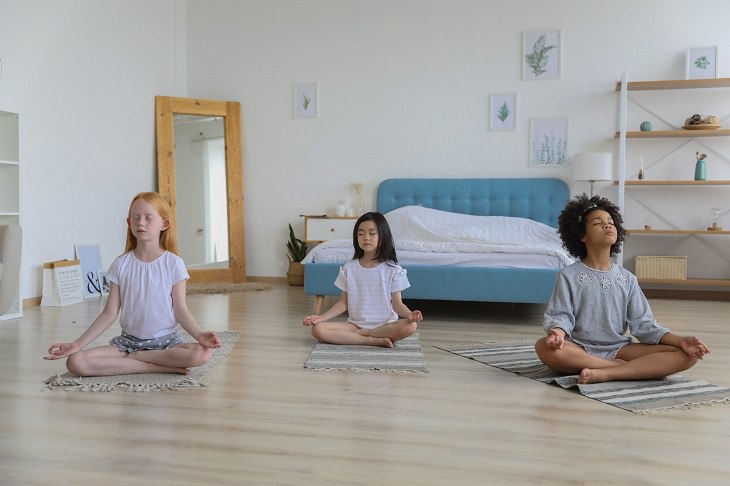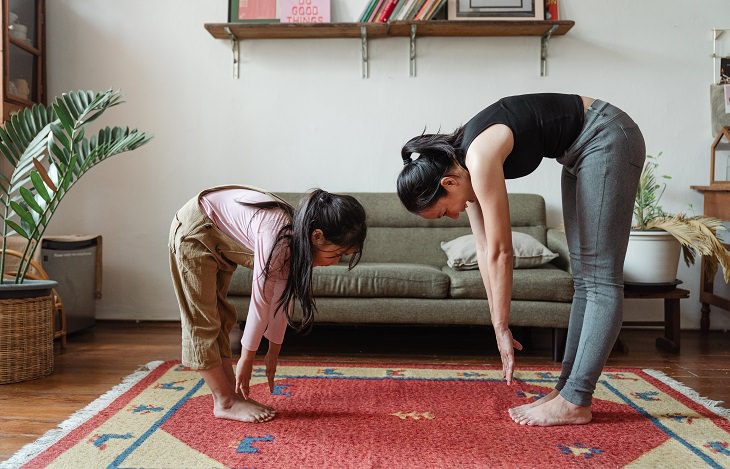You've always been interested in meditation, perhaps even tried it a few times, and now you want to get your kids involved but don't know how? Alternatively, you're looking for a method that will help them relax a bit and offer them a variety of other benefits? Either way, this article is exactly for you. You'll find here a complete guide we’ve put together just for you, which first and foremost will explain what amazing benefits it has for children. Afterwards, you'll discover wonderful methods that will help you practice meditation with children from age two to adolescence. After they stick to it for a while, you'll see the wonderful positive change and blessed calm it brings into your lives.
A general explanation about practicing meditation with children and its benefits for them
Meditation is a mental practice that helps a person remain calm and connect with themselves. Although it can seemingly be practiced in the same way by children and their parents, adults have more patience to perform it, as well as the ability to look inward and stay focused for extended periods. Therefore, if you want to teach your children to meditate, you need to present it as a fun activity that includes aids and methods that suit them, such as stories, toys, fun videos, and movement. Additionally, since at first, they won't have much patience to sit in one position, do it in short bursts — you'll see that with time, they will meditate longer than before. If they stick with it for a long time, they will enjoy various benefits such as:
- Relaxation that will also give you some peace and quiet
- The ability to manage emotions and cope with anger and stress
- Faster and better sleep
- Improved focus and information retention
- Enhanced creativity and mood
As mentioned, few children can start meditating on their own, and therefore they need a push and support from their parents in this matter. You're welcome to discover the ways that will encourage your child to meditate and how to perform it, according to their age. Of course, you're welcome to continue practicing meditation together even as the years go by, if the exercises still suit your child and they are interested in continuing. Generally, it is recommended to meditate for about 5 minutes as part of your morning routine or just before bedtime.
Age 2 – Meditation through light conversation
At this age, it's recommended to teach your child to meditate through a light conversation that will help their brain recognize stress signals and restore balance to the body. Remember, they don't yet have the vocabulary to explain to you when they need meditation or the relaxation it provides, so it's up to you to understand when they are required. Here's how to conduct the conversation:
- Ask them what makes them feel happy, and request they touch the parts of their body where they feel it.
- Ask them to think of something sad and show you where they feel it in their body.
- Take a few deep breaths together to release unpleasant feelings, and encourage them to keep doing it as you go along.
Preschool Age
There are two great exercises that may help your child, each focusing on a different aspect of meditation.
Balloon Pose
In the following video, you'll discover a cool pose your child will probably enjoy practicing, especially if you incorporate a lot of imagination! Through it, they will learn breathing techniques that will help them feel the changes happening in their body.
- Sit on a chair or cross-legged on the floor, and ask your child to choose the color of the balloon they want to inflate. Also say what color you'd like your balloon to be.
- Relax your body, take a deep breath, and then exhale slowly through your nose.
- Now, try to inflate your imaginary balloon. To do this, inhale deeply and fill your belly with air – inflate it as much as possible. At the same time, hold your hands close to your mouth, as if you're holding the balloon's opening.
- Exhale slowly through your nose, releasing all the air gathered in your belly. At the same time, move your hands holding the imaginary balloon further apart as it expands.
- Repeat this again and again, and ask your child every few exhales if they feel their body relaxing.
Story in a Lying Pose
In addition to the changes happening in your child's body, they also begin to notice different details in the stories they hear – a skill that can be used for meditation. This exercise is especially recommended to do before bedtime for about 5 minutes.
- Ask your child to lie on their back with their arms by their sides, on the floor or in bed – this is a natural position for relaxation. You can lie down next to them, on the floor.
- Ask them to take a deep breath and exhale, and in the meantime tell them a story featuring their favorite toy or pet. If the story doesn't interest them, ask them to smell an imaginary flower, and ask how it looks and smells. If they refuse to listen to you, practice the breaths yourself while lying on the floor, and soon they'll join you.
Elementary School Children
At this stage, many children store up anger in their bodies toward a teacher who gave a lot of homework, a friend who hurt them, and various other things that seem unfair to them. You can help your child release this negative energy with a fun meditation that will calm their mind and body. It's recommended to do it for at least 5 minutes at the beginning of the day, to start it "clean" and with a fresh slate, or at the end of the day – to leave the anger behind. To make the meditation more comfortable for your child, you can suggest doing it to the sound of music of their choice, or alternatively with a guided meditation recording. You're welcome to join the students in the following video, and meditate together for about 5 minutes, following the instructions provided both in the video and right after it. If your child doesn't yet understand English, you’re welcome to give them the instructions yourself and ask the questions heard in the video.
- Sit on a chair, close your eyes, and feel your weight resting on it.
- Inhale deeply for 3 seconds, and exhale for 3 seconds. Repeat this throughout the exercise, and carry out the following instructions in between breaths.
- Feel your feet resting on the floor – are they light or heavy? Warm or cold?
- Feel your back resting against the chair.
- Feel your stomach – is it tense or relaxed?
- Feel your hands – are they stiff or relaxed? If they're tense, release them.
- Be aware of your arms and shoulders, and feel them.
- Be aware of your neck, and relax it.
- Relax your face.
- Finally, be aware of your entire body.

Adolescence
If elementary school children store up anger in their bodies – imagine how much it intensifies as they grow and enter adolescence. Therefore, at this age, you should recommend that your child meditate, maybe even together with you, to train their mind to ignore the noises coming from the stressful world they live in, and to focus on their body. You should find out what type of meditation suits them, for example, if they're interested in art – perhaps meditating through mandala coloring would suit them, and if they're into sports, it may be better to do yoga exercises together, like the ones in this article which you'll discover below. You can also take them on a kind of guided journey in a place where they're physically comfortable and can breathe deeply and slowly, asking them the following questions to help them become aware of their surroundings in different ways:
- What do they see around them? For example, colors, textures, and objects.
- What do they feel physically? For example, if you're in a room – a soft pillow, and if you're at the beach – warm sand.
- What do they smell? Are the scents sweet? Are they familiar to them?
Additionally, you can do the following yoga exercise with them:
- Sit on the floor in a cross-legged position.
- Rest your hands on the floor in front of you, as far as possible, and look down.
- Inhale deeply.
- Lean your body forward, on your hands, so that your chest is in line with


